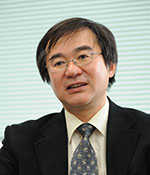
Electronics, Communications and Networks


Biography: Tad MATSUMOTO received his B.S., M.S., and Ph.D. degrees from Keio University, Yokohama, Japan, in 1978, 1980, and 1991, respectively, all in electrical engineering. He joined Nippon Telegraph and Telephone Corporation (NTT) in April 1980. Since he engaged in NTT, he was involved in a lot of research and development projects, all for mobile wireless communications systems. In July 1992, he transferred to NTT DoCoMo, where he researched Code-Division Multiple-Access techniques for Mobile Communication Systems. In April 1994, he transferred to NTT America, where he served as a Senior Technical Advisor of a joint project between NTT and NEXTEL Communications. In March 1996, he returned to NTT DoCoMo, where he served as a Head of the Radio Signal Processing Laboratory.
In March 2002, he moved to University of Oulu, Finland, where he served as a Professor at Centre for Wireless Communications. In 2006, he served as a Visiting Professor at Ilmenau University of Technology, Ilmenau, Germany, funded by the German MERCATOR Visiting Professorship Program. In April 2007, he returned to Japan and since then he has been serving as a Professor at Japan Advanced Institute of Science and Technology (JAIST), while also keeping the position at University of Oulu. Prof. Matsumoto has been appointed as a Finland Distinguished Professor for a period from January 2008 thru December 2012, funded by the Finnish National Technology Agency (Tekes) and Finnish Academy, under which he preserves the rights to participate in and apply to European and Finnish national projects. Prof. Matsumoto is a recipient of IEEE VTS Outstanding Service Award (2001), Nokia Foundation Visiting Fellow Scholarship Award (2002), IEEE Japan Council Award for Distinguished Service to the Society (2006), IEEE Vehicular Technology Society James R. Evans Avant Garde Award (2006), and Thuringen State Research Award for Advanced Applied Science (2006), 2007 Best Paper Award of Institute of Electrical, Communication, and Information Engineers (IEICE) of Japan (2008), Telecom System Technology Award by the Telecommunications Advancement Foundation (2009), and IEEE Communication Letters Exemplifying Reviewer Award (2011). He is a Fellow of IEEE. He is serving as an IEEE Vehicular Technology Distinguished Lecturer since July 2011.
Speech Title: Cooperative Communications: from the correlated source coding theorem viewpoint
Abstract:
A goal of this talk is to provide audience with the knowledge about the relationship between lossy-forwarding relay systems and the Distributed Coding techniques for correlated sources in cooperative communications. It is shown that performance of the conventional decode-and-forward system can significantly be improved by performing another interleaving at the relay, with which the resulting network structure is equivalent to distributed turbo code. Furthermore, since the knowledge about the bit error probability of the source-relay node can be used as the correlation between the two frames, one from the source, and the other from the relay, we can well exploit the theorem for correlated sources with a helper; With the utilization of the theorem, the relay can forward the frame even though it detects errors in the information part, and the destination can recover the data losslessly.
Then, this talk further introduces the idea, from lossless-likn-design-based to lossy-based. In this part, we assume that none of the relays at the final stage has no errors in the information parts of the frames. This category of the problems belongs to Distributed Lossy Coding, represented by the Chief Executive Officer (CEO) problem, in Network Information Theory. This talk briefly explains major results of analysis we have achieved up until now, but because of the time limitation, we do not go into very deep level of mathematical derivations of the formulas.